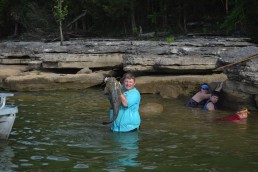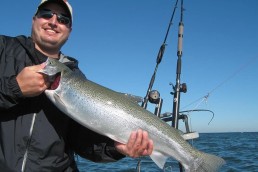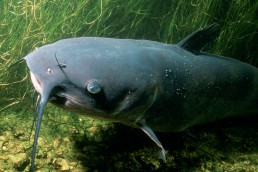Hands-on Cats: Noodling Near the Neon Rainbow
SHARE THIS POST
“Music City,” Nashville, Tenn., has a lot to offer—great music and food, awesome people and a bustling city environment. What it also has is the Cumberland River and Percy Priest and Old Hickory lakes.
These rivers and impoundments are home to not only bass and crappies, but also some monster catfish. These can be caught in all the traditional ways, such as rod and reel, trotlines and jug fishing, but the method that’s most fun is “noodling.”
Noodling for big catfish has become popular over the last few years, and here in mid-Tennessee, it’s booming.
Noodling is the art of using your hands to catch these big catfish. Yes, your hands are the primary tools for this style of fishing. This method is practiced in the South. I’ve found out from my research that it’s so effective many states have made it illegal based on both angler safety and fish population concerns. It appears to only be legal in 13 states currently.
Noodling has become part of a southern culture and phenomenon of sorts. In fact, the New York Times ran an article about Noodling in 2006 titled, “In the Jaws of a Catfish.” That same year, ESPN.com posted an article called, “Out There: A baptism! Noodling for catfish.”
To say this sport has gotten a lot of mainstream attention is an understatement of epic proportions. Television has not missed out of this sport either. The Animal Planet ran a series called Hillbilly Handfishin’, and noodling has been the topic on the popular show River Monsters as well.
On my first trip out, I assumed that this was a non-targeted sport where you just caught whatever catfish happened to be living in a given hole at the given time—was I ever wrong.
Although flathead catfish tend to live in these holes all year, the rest of the catfish family also frequents holes in spring, during the spawn. These guys who perform noodling know which species of catfish should be in the holes on a given day based on water temperature alone. The only catfish that seems to be the nemesis of the noodler is the blue catfish, apparently because it’s much meaner and more aggressive than its cousins, the flathead and channel.
After a very short boat ride to the prime site, we had arrived at what was called the “catfish hotel,” a series of holes, some natural and others man-made in the lake ledges by the anglers. (Many spend a lot of time in the winter locating and building holes while the lakes are at winter pool. This sport is scientific and not quite as “hillbilly” as some may be led to believe.)
Are you enjoying this post?
You can be among the first to get the latest info on where to go, what to use and how to use it!
This game is very unique, as it’s block-and-tackle fishing at its best. Once you’re in the water, feeling around for your holes is the first order of business. Once the holes are located, a “noodle” with the stick starts probing a hole for fish—some folks use their hands as well at this point, or as they told me, as a “soft spot.”
But once the catfish is located, things certainly do get interesting.
I have always thought that the fish would charge out and bite the stick, but that’s not always the case. These fish will just lay right there, try to run out of the hole or they will get good and mad and grab a hold of your stick.
The “stringer man” either reaches into the hole or dives under first and then reaches inside the opening to “catch” the fish. Once they get the beast “strung” out of the hole, they come all together, angler and fish!
At this point, it’s utter chaos—for a few seconds.
The most interesting thing I learned on this adventure was the fact that in the month of June it was expected that each hole contain a male and a female fish in it. That is a true assumption for about 95 percent of the time.
All said and done, we kept a few male fish and the guys had a really nice, fresh fish fry for me.
This is something that everyone should go experience, as it’s both fun and oddly enough, very educational.
MWO
SHARE THIS POST
You may also like...
Did you enjoy this post?
You can be among the first to get the latest info on where to go, what to use and how to use it!
MWO
We believe being outdoors is good. With more than 1,000 articles each year, MidWest Outdoors magazine is all about sharing outdoor experiences with you—where to go, what to use and how to use it… whether you’re close to home or on that trip of a lifetime.





